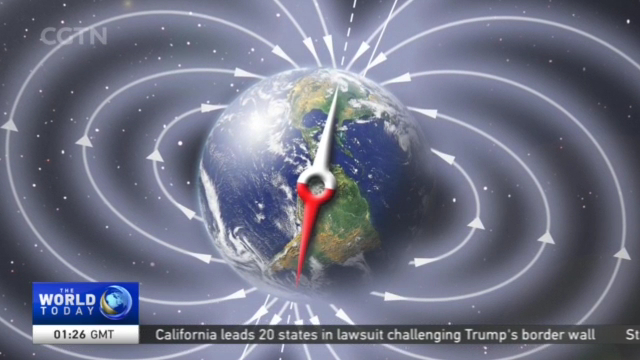
11:31, 08-Apr-2019
Magnetic Field in Motion: Shifts at North Pole strain global navigation
Updated
11:30, 11-Apr-2019
02:57

GPS users rely on the magnetic North Pole to help orient them. But the planet's magnetic field lines are constantly moving. And as CGTN's Hendrik Sybrandy reports, scientists have been scrambling to keep up.
Brandon Jewett is a commercial pilot who, in his spare time, flies his Douglas DC-3, a propeller-driven plane that was used to transport troops during World War Two.
Brandon Jewett Pilot: "This is like driving a motorhome."
The cockpit is appropriately retro.
BRANDON JEWETT PILOT "So this is our main instrument panel here. But here's our whiskey compass, front and center if you will."
Whiskey compass, named for the alcohol that once lubricated these devices.
Navigation has come a long way since the days of American aviator Charles Lindbergh.
From "The Spirit of St. Louis": "Where am I? I could be anywhere from Iceland to the coast of Africa."
But in this high-tech, GPS-driven age, the compass remains an indispensable tool for pilots.
BRANDON JEWETT PILOT "And to this day is one of the original required basic instruments that every single airplane must have."
HENDRIK SYBRANDY DENVER "Most compasses use Earth's magnetic field to tell us which way is north. The problem is the magnetic North Pole has always had a hard time staying in one place. In fact, it was moving at the rate of 10-15 kilometers per year from the Canadian Arctic towards Siberia."
Then in the 1990s, it sped up to 55 kilometers per year.
ARNAUD CHULLIAT RESEARCH SCIENTIST, UNIVERSITY OF COLORADO, BOULDER "I find it spectacular that the speed increased that much in such a short period of time."
Arnaud Chulliat, a research scientist with the University of Colorado Boulder, says the move was likely caused by the flow of liquid iron deep inside Earth's core.
ARNAUD CHULLIAT RESEARCH SCIENTIST, UNIVERSITY OF COLORADO, BOULDER "And these motions generate most of the Earth's magnetic field, and they're also responsible for variability of this magnetic field."
Gradually, the Siberian sprint, as it's been called, has made the navigational maps used by airlines and ships out of date.
BRANDON JEWETT PILOT "Where it becomes critical for a pilot is if you were trying to navigate with an old chart, you'd have inaccurate information."
In February, scientists released an emergency update to the World Magnetic Model that aids global navigation. And over time, airports have had to rename runways that were named for their magnetic heading.
BRANDON JEWETT PILOT "They've all had to renumber the runways because it's changed that much."
The polar drift has even led to speculation that a weakening magnetic field might lead the north and south magnetic poles to flip spots which last happened 780,000 years ago. No signs of that just yet.
ARNAUD CHULLIAT RESEARCH SCIENTIST, UNIVERSITY OF COLORADO, BOULDER "I don't think there's any reason for particular concern."
Jewett has updated his compass. It's an instrument pilots can't do without.
BRANDON JEWETT PILOT "There's endless aviation stories of how the compasses saved their life. You know helped them find where they were going."
As for where the North Pole is going, it's anyone's guess. Hendrik Sybrandy, CGTN, Denver.

SITEMAP
Copyright © 2018 CGTN. Beijing ICP prepared NO.16065310-3
Copyright © 2018 CGTN. Beijing ICP prepared NO.16065310-3